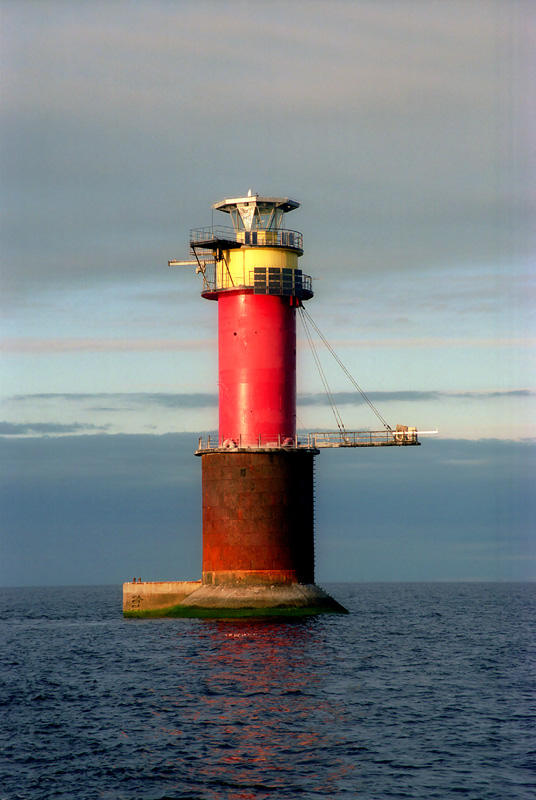Tallinnamadala (Revelstein, Revalstein) lighthouse is located 7.5 miles north of the island of Aegna in the Gulf of Finland on the shoal of the same name and warns people traveling in the Gulf of Finland and ships leaving the Gulf of Tallinn about dangerous shoals .
The shoal, located at the intersection of major waterways, was already a concern for seafarers during the Hanseatic trade. He is also mentioned in the 1695 Petter Gedda Baltic Sea atlas.
1718. in 2010, Peter I ordered to install a warning sign on Tallinnamadala, or if this should not be possible, to build four stone pillars on Naissaari and Aegna instead of wooden slat signs. They were probably intended to mark a safe shipping lane. In 1828, Major General Leonti
Spafarjev proposed to build a lighthouse on Tallinna Madala. Due to the lack of opportunities, the plan was not implemented. At the same time, the day marker built on Aegna Vulligrunn aimed at the tower of the Oleviste Church allowed Tallinnamadala to pass safely from the west.
1837. in 1st rank Captain Treskin presented the project of Tallinnamadala fireship.
The ship was planned to be 90 feet long, with a small reflector lantern raised on the mainmast and a fog clock on the deck. The project was not implemented due to lack of funds. However, as a result of the inspection of lighthouses and navigation safety in 1856, the Department of Hydrography decided that a lighthouse would be installed on Tallinna Madala.
Since 1858, a sailboat adapted as a light ship was anchored near the northern side of Tallinna Madala (59° 43.3' N, 24° 45.1' E) for the sailing season, with a lantern pulled from its mast in the dark. In 1864, it was replaced by a three-masted sailboat with a black painted iron hull, bought from England and rebuilt in St. Petersburg, with large white letters "R" and "P" painted on the sides, representing the first letters of the ship's name "Revelstein" in German and Russian.
The main and main masts of the fireship had truss balls with vertical black and white stripes. At daylight, the flag of the fireship was hoisted on the mainmast — a blue cross on a yellow background. In the dark, lanterns were drawn to the masts. The light of the tallest lantern on the main mast, 12 m above sea level, could be seen 7 miles away.
Each lantern had 8 oil lamps equipped with reflectors. In case of fog, the fireboat had a hand siren, the sound of which could be heard 1.5 miles away.
1898. In addition, fireship "Revalstein" No. 2, which had been built
, was brought to Tallinn by1871. in St. Petersburg. The ship was equipped with dioptric triple lanterns that could be screwed onto the mast. The taller, main-masted lantern was 30 feet (9 m) above sea level and could be seen 6 miles away. The fireship had a steam siren that sounded 4 miles away.
1909. changes had taken place on the fireship for the year The name "Revelstein" was written on the sides in black Slavic letters on a light yellow strip.
1914. By 2015, the light ship was painted red, the name of the ship was written in black Slavic letters on a white strip on the sides.
1916. year, the lightship had a red ball on the mainmast, at night the lights were still on the mainmast and besaan mast. In 1922, there was an acetylene lantern with a plinking device on the main mast of the "Revelstein" 30 m above sea level, the ship is equipped with a radio station and the name is written in Latin letters.
1925. this ship was replaced by a two-masted steamship
that had been located in the shallows of Hiiu"Nekmangrund". The sides of the ship with a red hull received the inscription "Revalstein" in white letters. There were two red spheres in the first mast of the ship. The light of the acetylene lantern, 17 m above sea level, could be seen 11 miles away. The fireship was equipped with a signal station, a morse beacon, a radio station, a fog siren, a fog clock and an underwater clock. From December 11, 1933, the lightship got the new name "Tallinn". By 1936, the fireship already had a radio beacon.
1940. in 2010, a nautophone was in use.
After the Second World War, the lightship "Tallinn" is noted in the 1950 list of lighthouses. A two-masted red-painted steamship is described, which had an acetylene plink lantern on the foremast at a height of 17 m and the name of the ship with white Slavic letters on the sides. The fireship was equipped with a nautophone, a fog siren, a clock and a radio beacon. Is the light ship in 1950 to Tallinna Madala
(59° 43' N, 24° 43' E) reached is not known. According to the Sea Lexicon, the fireship lay low until 1949, when it was replaced by a fire buoy.
The construction of the lighthouse on Tallinna Madala started in 1960. A box-shaped foundation with hollow sections was made of reinforced concrete at the wharf in the port of Tallinn, which was launched into the sea, towed onto a prepared base and sunk. The spring frost of 1961 destroyed the first structure, because the foundation could not be loaded with stones and concrete to the required extent in the fall. The work had to be started all over again.
A new floating vessel weighing 2000 tons was prepared and towed to the shallows, where it was sunk to a depth of 7 m and filled with gravel to form the foundation for the lighthouse.
The body was made of monolithic concrete at the bottom and the top
